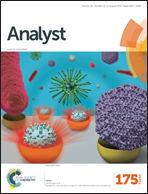Anti-CD155 and anti-CD112 monoclonal antibodies conjugated to a fluorescent mesoporous silica nanosensor encapsulating rhodamine 6G and fluorescein for sensitive detection of liver cancer cells
Abstract
A novel method for sensitive detection of liver cancer cells using anti-CD155 and anti-CD112 monoclonal antibodies conjugated to ultrabright fluorescent mesoporous silica nanoparticles (FMSNs) encapsulating Rhodamine 6G and fluorescein was developed. The diameter of the obtained nanoparticles was 90 nm, and the quantum yield was 69%. Because the emission of fluorescein has a high degree of overlap with the excitation of Rhodamine 6G, and these two dyes were sufficiently close to each other on the nanoparticles, fluorescence resonance energy transfer can occur between these two dyes. This transfer not only maintains the original feature of the nanochannels and the skeletal network of the silica weakening the inner filtering of the dye, but also makes the excitation peak of the nanoparticles wider and increases the useful load amount of the dye. Because the wider Stokes shifts weaken the interference of excitation, the detection sensitivity is enhanced at the same time. The NaIO4 oxidation method does not use a cross-linker but rather uses covalent immobilization of the monoclonal antibodies on the FMSNs. This method can maintain the activity of the monoclonal antibodies more easily than the glutaraldehyde method. These advantages ensure that the nanosensor has high sensitivity and specificity for detecting liver cancer SMMC-7721 and HHCC cells. The in vivo imaging experiment also ensured that the biosensor can target tumor tissue in mice.


 Please wait while we load your content...
Please wait while we load your content...